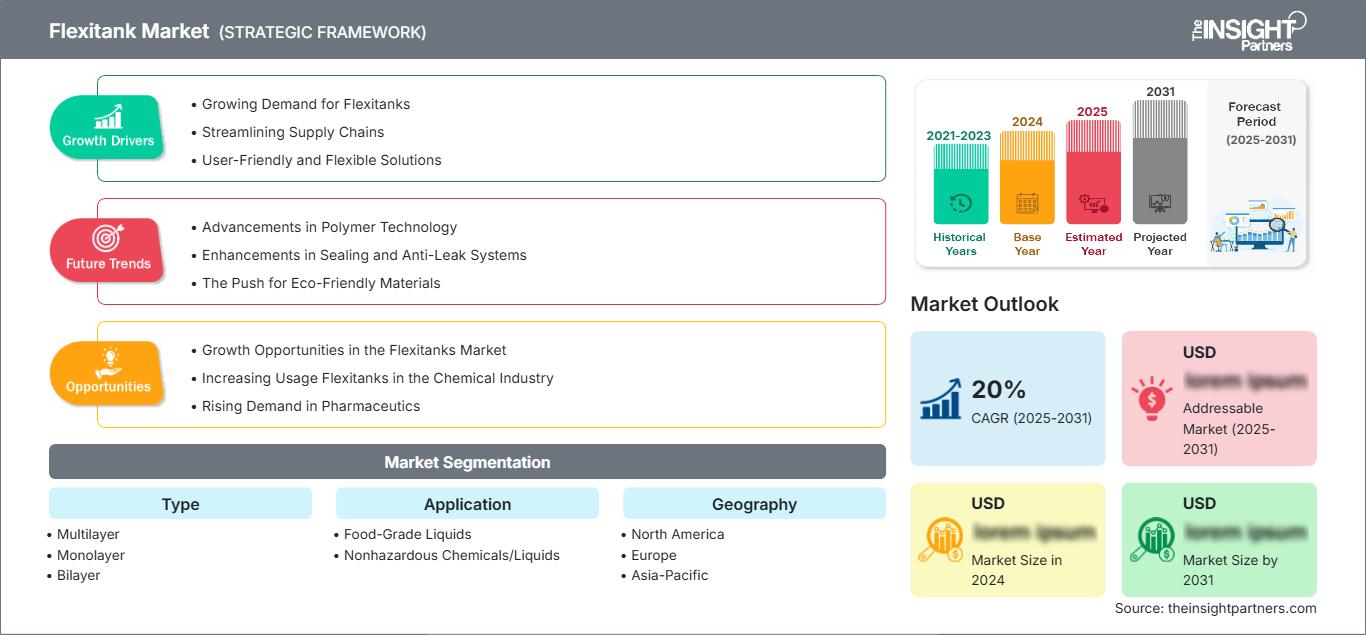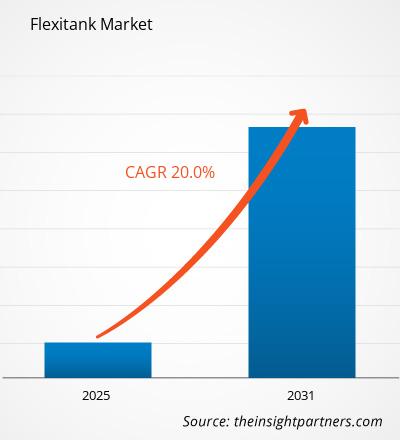The Flexitank Market size is expected to reach US$ 1.35 billion by 2031. The market is anticipated to register a CAGR of 15.2% during 2025-2031.
The report presents analysis based on type (multilayer, monolayer, and bilayer). The report is segmented by application (food-grade liquids, nonhazardous chemicals/liquids, and others). The global analysis is further broken-down at regional level and major countries. The market size and forecast at global, regional, and country levels for all the key market segments are covered under the scope. The report offers the value in USD for the above analysis and segments. The report provides key statistics on the market status of the key market players and offers market trends and opportunities.
Purpose of the Report
The report Flexitank Market by The Insight Partners aims to describe the present landscape and future growth, top driving factors, challenges, and opportunities. This will provide insights to various business stakeholders, such as:
- Technology Providers/Manufacturers: To understand the evolving market dynamics and know the potential growth opportunities, enabling them to make informed strategic decisions.
- Investors: To conduct a comprehensive trend analysis regarding the market growth rate, market financial projections, and opportunities that exist across the value chain.
- Regulatory bodies: To regulate policies and police activities in the market with the aim of minimizing abuse, preserving investor trust and confidence, and upholding the integrity and stability of the market.
Flexitank Market Segmentation Type
- Multilayer
- Monolayer
- Bilayer
Application
- Food-Grade Liquids
- Nonhazardous Chemicals/Liquids
You will get customization on any report - free of charge - including parts of this report, or country-level analysis, Excel Data pack, as well as avail great offers and discounts for start-ups & universities
Flexitank Market: Strategic Insights

-
Get Top Key Market Trends of this report.This FREE sample will include data analysis, ranging from market trends to estimates and forecasts.
Flexitank Market Growth Drivers
- Growing Demand for Flexitanks: Flexitanks are in high demand as a cost-effective means of shipping bulk liquids in an economically effective manner. The growing need for efficient cargo transportation of liquids is driving demand within the market. Food and beverage, chemicals, and pharmaceutical industries are utilizing flexitanks since they optimize space inside the containers.
- Streamlining Supply Chains: As international trade expands, companies will need some imaginative solutions to help streamline their supply chain processes. Flexitanks make it possible to move more liquid volumes in regular shipping containers. This efficiency saves shipping costs and contributes towards a reduction in environmental degradation, factors that might be part of the sustainability goals most organizations are trying for.
- User-Friendly and Flexible Solutions: In addition, flexitanks have cropped up as they are user-friendly and flexible. They are faster to assemble and result in less cleaning compared with traditional tankers. Flexibility at this fast-rate of the market is crucial in terms of both time and resources. Companies aim for efficiency in operations and hence continue to order these solutions.
Flexitank Market Future Trends
- Advancements in Polymer Technology: Innovations in polymer technology, coupled with new breakthroughs in material science that could lead to a new age of more robust, lighter yet more reliable and durable material, have led consumers to enjoy greater safety and reliability associated with the flexitanks.
- Enhancements in Sealing and Anti-Leak Systems: New designs, including better sealing and anti-leak systems, are also adding to the growth of the market. These features avoid contamination and leakage, which have been the biggest source of concern for many manufacturers and logistics providers. Companies are now opting for safe and secure transportation methods, and technology up-gradations in such parameters are becoming more significantly essential to meet industrial standards.
- The Push for Eco-Friendly Materials: Furthermore, eco-friendly materials form a high-growth research area. With the focus on going green, manufacturers of flexitanks explore biodegradable or recyclable materials as they can reduce exposure to environmental damages and attract green-thinking companies to sustain an eco-friendly client base.
Flexitank Market Opportunities
- Growth Opportunities in the Flexitanks Market: Expansion in other industries like chemical, pharmaceutical, and cosmetic present great avenues for growth for the flexitanks market, no longer restricted to the food and beverages sector, where most of its initial use was in the transport of liquid.
- Increasing Usage Flexitanks in the Chemical Industry: In the chemical industry, it has recently emerged as a common practice for the transportation of non-hazardous liquids in flexitanks, offering an economical alternative to traditional tanker options. Flexitanks are prefabricated large tubes, made out of flexible plastic/PVC material. It accommodates shipment in bulk while keeping the integrity of the product. Manufacturers who have a requirement for a very efficient logistics solution find it attractive. This would be a healthy trend for applications encompassing a much broader range of liquid cargo.
- Rising Demand in Pharmaceutics: Pharma also gains value in the use of flexitanks to transport large liquid volumes, which include vaccines and other medical supplies. Overlapping with flexitank use benefits such as the limitation of risks in contamination and ensuring product quality, comes the need for safe and reliable transportation methods. Acceptance of pharmaceuticals is growing with these current developments, doing well for demand in the future.
The regional trends and factors influencing the Flexitank Market throughout the forecast period have been thoroughly explained by the analysts at The Insight Partners. This section also discusses Flexitank Market segments and geography across North America, Europe, Asia Pacific, Middle East and Africa, and South and Central America.
Flexitank Market Report Scope
| Report Attribute | Details |
|---|---|
| Market size in 2024 | US$ XX Billion |
| Market Size by 2031 | US$ 1.35 billion |
| Global CAGR (2025 - 2031) | 15.2% |
| Historical Data | 2021-2023 |
| Forecast period | 2025-2031 |
| Segments Covered |
By Type
|
| Regions and Countries Covered |
North America
|
| Market leaders and key company profiles |
|
Flexitank Market Players Density: Understanding Its Impact on Business Dynamics
The Flexitank Market is growing rapidly, driven by increasing end-user demand due to factors such as evolving consumer preferences, technological advancements, and greater awareness of the product's benefits. As demand rises, businesses are expanding their offerings, innovating to meet consumer needs, and capitalizing on emerging trends, which further fuels market growth.

- Get the Flexitank Market top key players overview
Key Selling Points
- Comprehensive Coverage: The report comprehensively covers the analysis of products, services, types, and end users of the Flexitank Market, providing a holistic landscape.
- Expert Analysis: The report is compiled based on the in-depth understanding of industry experts and analysts.
- Up-to-date Information: The report assures business relevance due to its coverage of recent information and data trends.
- Customization Options: This report can be customized to cater to specific client requirements and suit the business strategies aptly.
The research report on the Flexitank Market can, therefore, help spearhead the trail of decoding and understanding the industry scenario and growth prospects. Although there can be a few valid concerns, the overall benefits of this report tend to outweigh the disadvantages.
Frequently Asked Questions
What is the future trend for the flexitank market?
Which is the fastest growing segment based on type?
Based on geography, which region held the largest share of the flexitank market?
What are the driving factors impacting the flexitank market?
What are the key players operating in the flexitank market?
What is the expected CAGR of the Flexitank Market?
- Historical Analysis (2 Years), Base Year, Forecast (7 Years) with CAGR
- PEST and SWOT Analysis
- Market Size Value / Volume - Global, Regional, Country
- Industry and Competitive Landscape
- Excel Dataset
Recent Reports
Testimonials
Reason to Buy
- Informed Decision-Making
- Understanding Market Dynamics
- Competitive Analysis
- Identifying Emerging Markets
- Customer Insights
- Market Forecasts
- Risk Mitigation
- Boosting Operational Efficiency
- Strategic Planning
- Investment Justification
- Tracking Industry Innovations
- Aligning with Regulatory Trends





















 Get Free Sample For
Get Free Sample For